Informatics Report on the Use of 3D Printing in Various Businesses
VerifiedAdded on 2023/06/15
|13
|2474
|394
Report
AI Summary
This report evaluates the application of 3D printing across various business sectors, highlighting its similarity to additive manufacturing and outlining the 3D printing process. Initially developed for rapid prototyping, 3D printing is now utilized in manufacturing, providing cost-effective solutions for small to medium-sized industries, although it's less suitable for large-scale production. The report details the working principles and diverse applications of 3D printing, including its increasing role in healthcare, aerospace, automotive, and chemical industries. It also discusses the potential for 3D printing to render traditional manufacturing obsolete due to its efficiency, reduced waste, and customization capabilities, while acknowledging that its widespread adoption faces challenges, particularly in high-volume production scenarios. The report concludes with recommendations for integrating 3D printing in prototyping and suggests further research to facilitate its broader adoption.
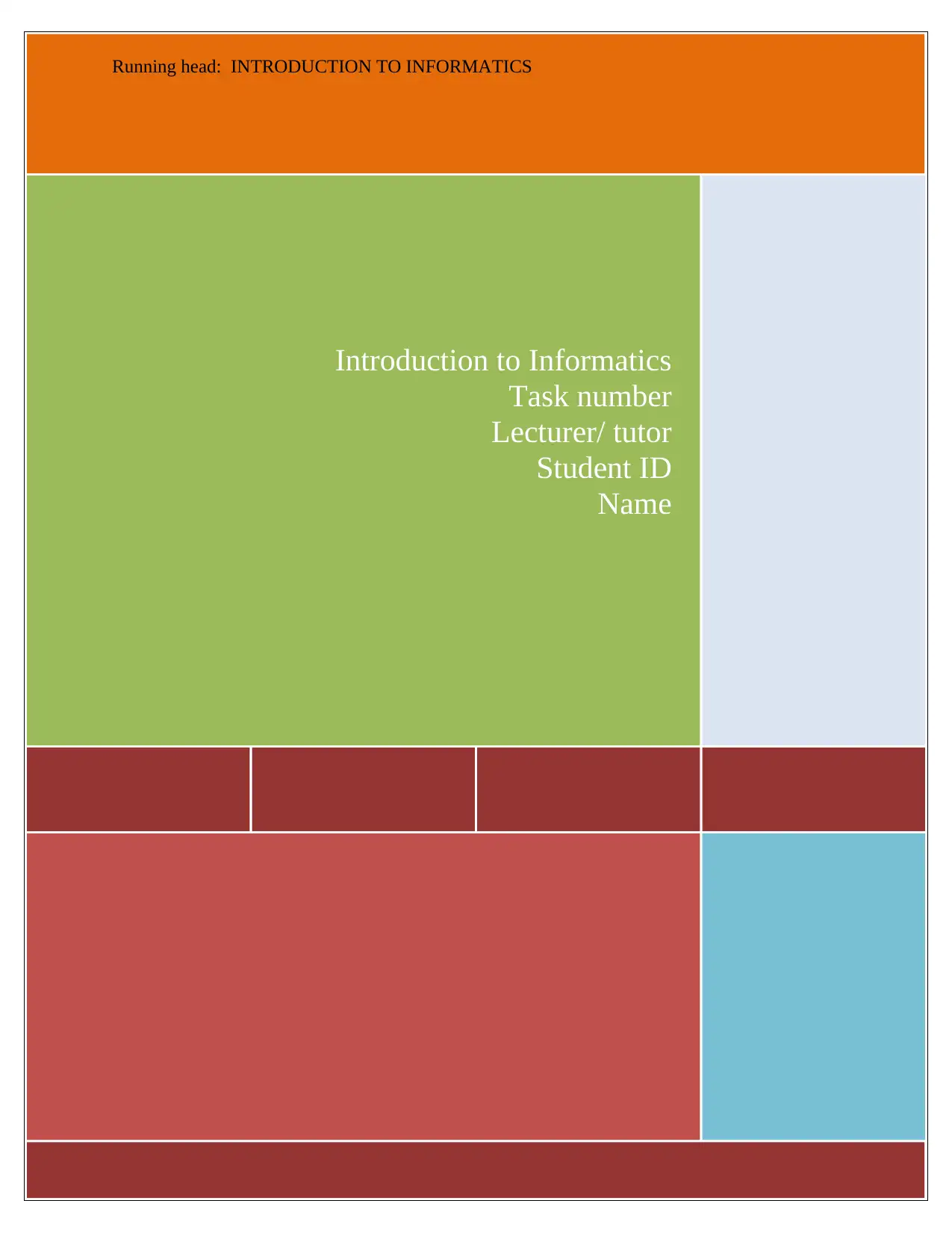
Introduction to Informatics
Task number
Lecturer/ tutor
Student ID
Name
Running head: INTRODUCTION TO INFORMATICS
Task number
Lecturer/ tutor
Student ID
Name
Running head: INTRODUCTION TO INFORMATICS
Paraphrase This Document
Need a fresh take? Get an instant paraphrase of this document with our AI Paraphraser
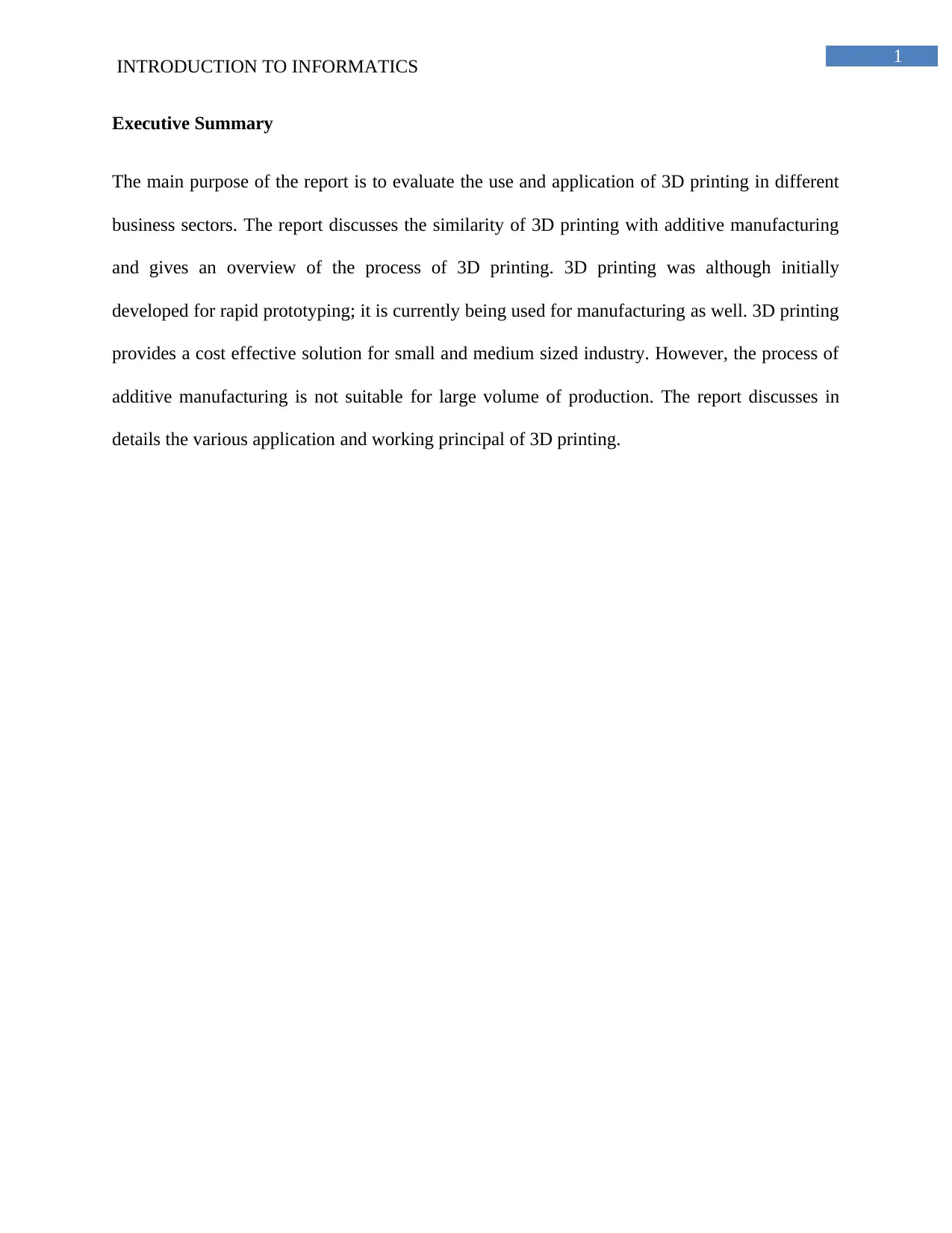
1
INTRODUCTION TO INFORMATICS
Executive Summary
The main purpose of the report is to evaluate the use and application of 3D printing in different
business sectors. The report discusses the similarity of 3D printing with additive manufacturing
and gives an overview of the process of 3D printing. 3D printing was although initially
developed for rapid prototyping; it is currently being used for manufacturing as well. 3D printing
provides a cost effective solution for small and medium sized industry. However, the process of
additive manufacturing is not suitable for large volume of production. The report discusses in
details the various application and working principal of 3D printing.
INTRODUCTION TO INFORMATICS
Executive Summary
The main purpose of the report is to evaluate the use and application of 3D printing in different
business sectors. The report discusses the similarity of 3D printing with additive manufacturing
and gives an overview of the process of 3D printing. 3D printing was although initially
developed for rapid prototyping; it is currently being used for manufacturing as well. 3D printing
provides a cost effective solution for small and medium sized industry. However, the process of
additive manufacturing is not suitable for large volume of production. The report discusses in
details the various application and working principal of 3D printing.
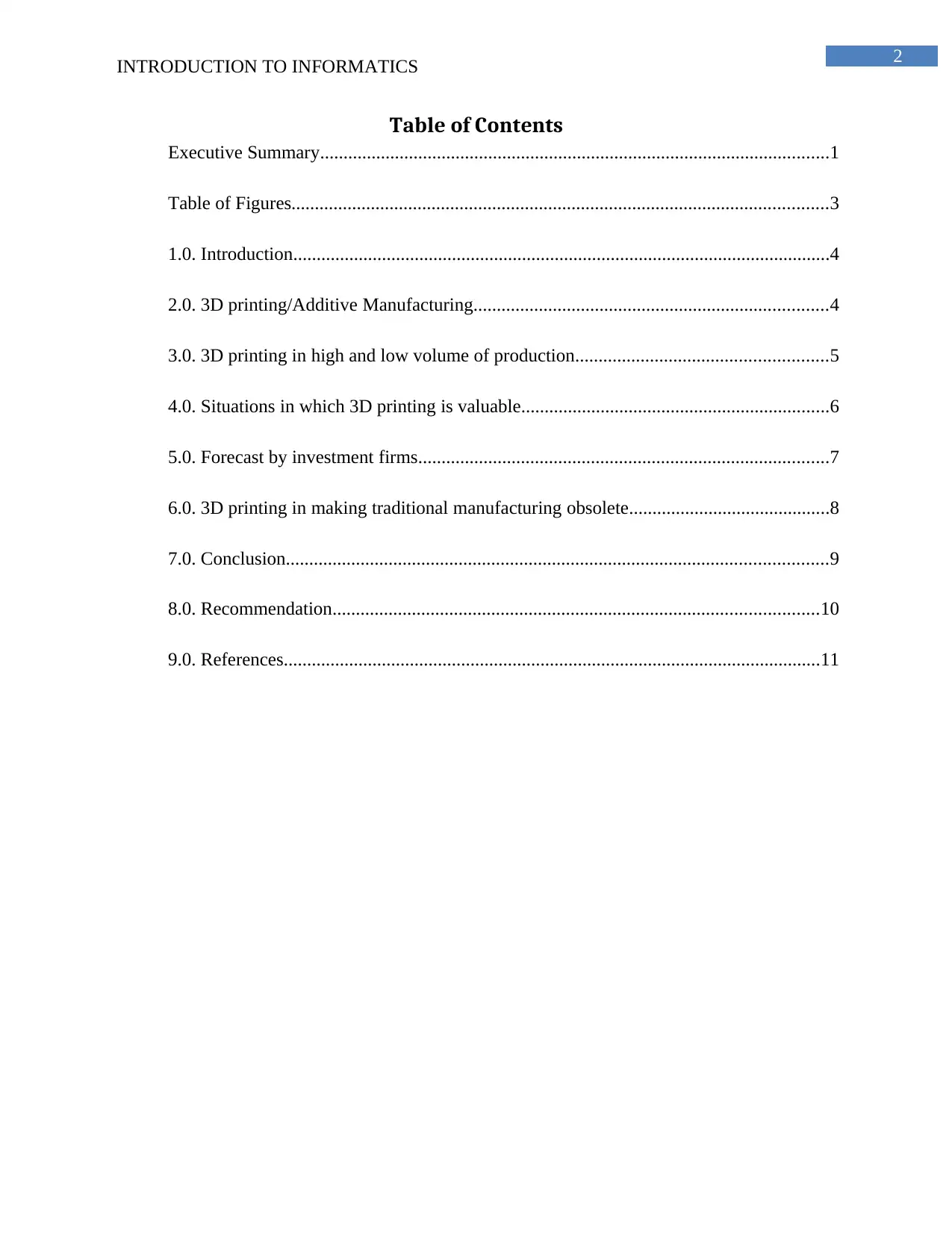
2
INTRODUCTION TO INFORMATICS
Table of Contents
Executive Summary.............................................................................................................1
Table of Figures...................................................................................................................3
1.0. Introduction...................................................................................................................4
2.0. 3D printing/Additive Manufacturing............................................................................4
3.0. 3D printing in high and low volume of production......................................................5
4.0. Situations in which 3D printing is valuable..................................................................6
5.0. Forecast by investment firms........................................................................................7
6.0. 3D printing in making traditional manufacturing obsolete...........................................8
7.0. Conclusion....................................................................................................................9
8.0. Recommendation........................................................................................................10
9.0. References...................................................................................................................11
INTRODUCTION TO INFORMATICS
Table of Contents
Executive Summary.............................................................................................................1
Table of Figures...................................................................................................................3
1.0. Introduction...................................................................................................................4
2.0. 3D printing/Additive Manufacturing............................................................................4
3.0. 3D printing in high and low volume of production......................................................5
4.0. Situations in which 3D printing is valuable..................................................................6
5.0. Forecast by investment firms........................................................................................7
6.0. 3D printing in making traditional manufacturing obsolete...........................................8
7.0. Conclusion....................................................................................................................9
8.0. Recommendation........................................................................................................10
9.0. References...................................................................................................................11
⊘ This is a preview!⊘
Do you want full access?
Subscribe today to unlock all pages.

Trusted by 1+ million students worldwide

3
INTRODUCTION TO INFORMATICS
Table of Figures
Figure 1: Increasing use of 3D printing in healthcare sector...............................................7
Figure 2: The prediction of 3D market in the year 2022.....................................................8
INTRODUCTION TO INFORMATICS
Table of Figures
Figure 1: Increasing use of 3D printing in healthcare sector...............................................7
Figure 2: The prediction of 3D market in the year 2022.....................................................8
Paraphrase This Document
Need a fresh take? Get an instant paraphrase of this document with our AI Paraphraser
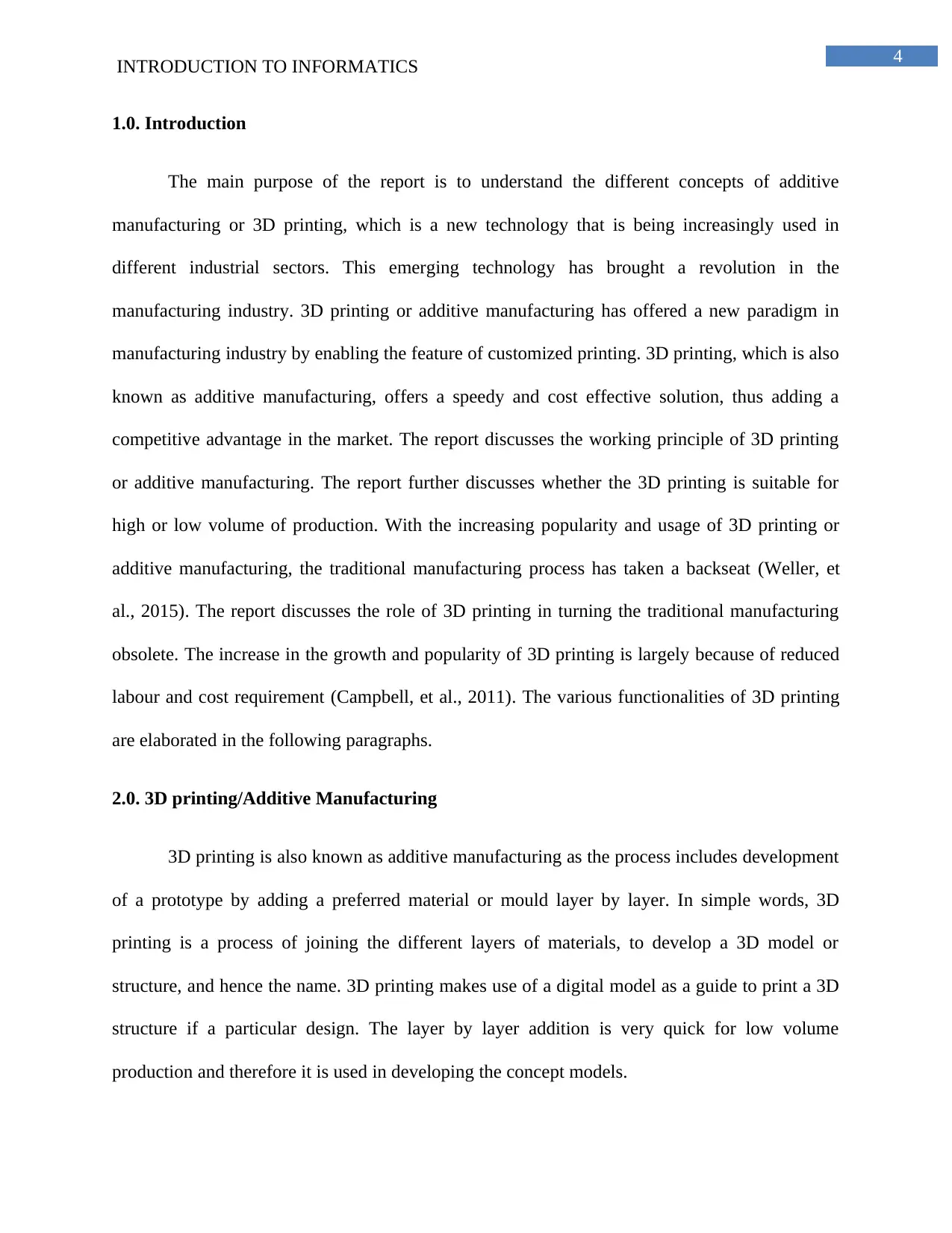
4
INTRODUCTION TO INFORMATICS
1.0. Introduction
The main purpose of the report is to understand the different concepts of additive
manufacturing or 3D printing, which is a new technology that is being increasingly used in
different industrial sectors. This emerging technology has brought a revolution in the
manufacturing industry. 3D printing or additive manufacturing has offered a new paradigm in
manufacturing industry by enabling the feature of customized printing. 3D printing, which is also
known as additive manufacturing, offers a speedy and cost effective solution, thus adding a
competitive advantage in the market. The report discusses the working principle of 3D printing
or additive manufacturing. The report further discusses whether the 3D printing is suitable for
high or low volume of production. With the increasing popularity and usage of 3D printing or
additive manufacturing, the traditional manufacturing process has taken a backseat (Weller, et
al., 2015). The report discusses the role of 3D printing in turning the traditional manufacturing
obsolete. The increase in the growth and popularity of 3D printing is largely because of reduced
labour and cost requirement (Campbell, et al., 2011). The various functionalities of 3D printing
are elaborated in the following paragraphs.
2.0. 3D printing/Additive Manufacturing
3D printing is also known as additive manufacturing as the process includes development
of a prototype by adding a preferred material or mould layer by layer. In simple words, 3D
printing is a process of joining the different layers of materials, to develop a 3D model or
structure, and hence the name. 3D printing makes use of a digital model as a guide to print a 3D
structure if a particular design. The layer by layer addition is very quick for low volume
production and therefore it is used in developing the concept models.
INTRODUCTION TO INFORMATICS
1.0. Introduction
The main purpose of the report is to understand the different concepts of additive
manufacturing or 3D printing, which is a new technology that is being increasingly used in
different industrial sectors. This emerging technology has brought a revolution in the
manufacturing industry. 3D printing or additive manufacturing has offered a new paradigm in
manufacturing industry by enabling the feature of customized printing. 3D printing, which is also
known as additive manufacturing, offers a speedy and cost effective solution, thus adding a
competitive advantage in the market. The report discusses the working principle of 3D printing
or additive manufacturing. The report further discusses whether the 3D printing is suitable for
high or low volume of production. With the increasing popularity and usage of 3D printing or
additive manufacturing, the traditional manufacturing process has taken a backseat (Weller, et
al., 2015). The report discusses the role of 3D printing in turning the traditional manufacturing
obsolete. The increase in the growth and popularity of 3D printing is largely because of reduced
labour and cost requirement (Campbell, et al., 2011). The various functionalities of 3D printing
are elaborated in the following paragraphs.
2.0. 3D printing/Additive Manufacturing
3D printing is also known as additive manufacturing as the process includes development
of a prototype by adding a preferred material or mould layer by layer. In simple words, 3D
printing is a process of joining the different layers of materials, to develop a 3D model or
structure, and hence the name. 3D printing makes use of a digital model as a guide to print a 3D
structure if a particular design. The layer by layer addition is very quick for low volume
production and therefore it is used in developing the concept models.
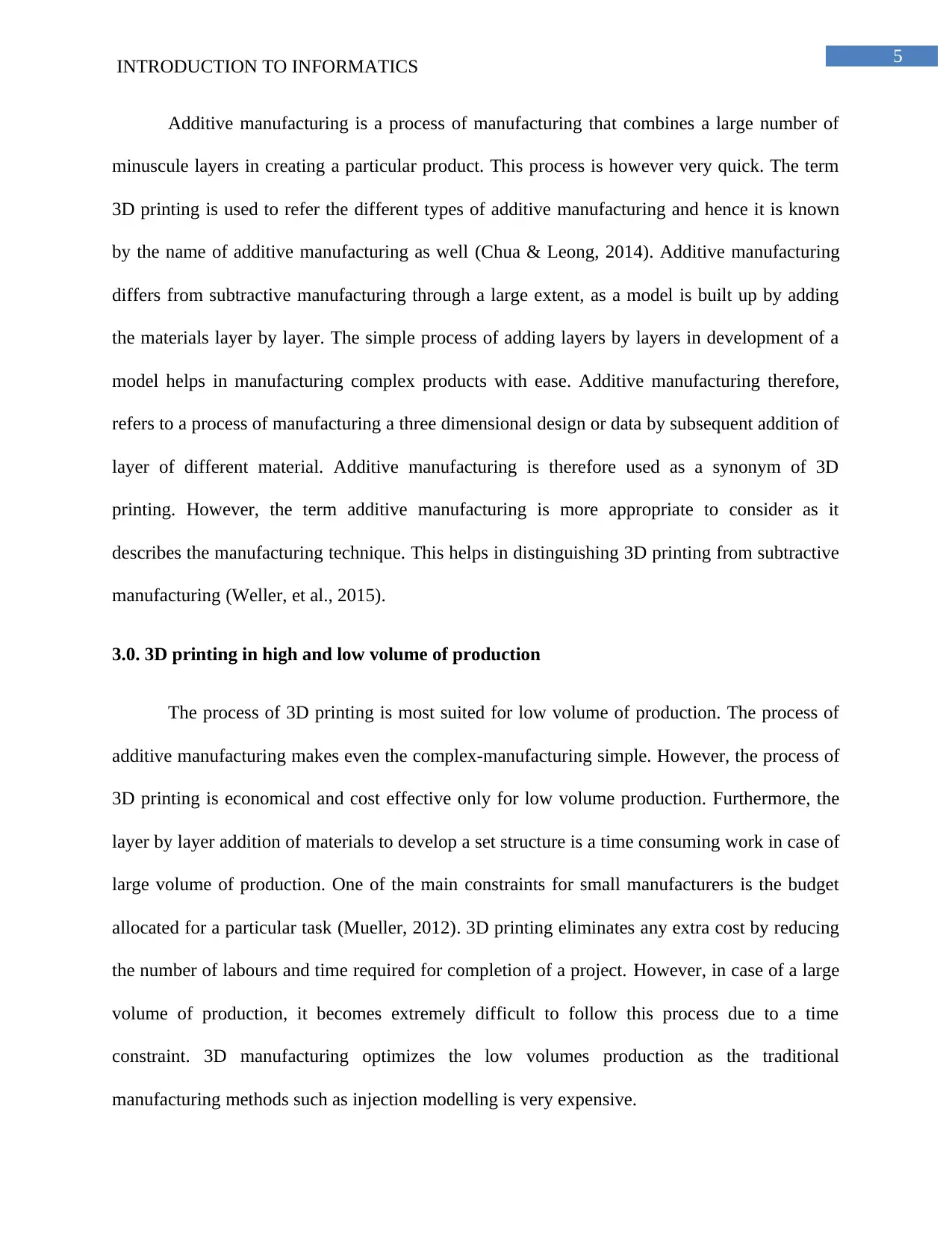
5
INTRODUCTION TO INFORMATICS
Additive manufacturing is a process of manufacturing that combines a large number of
minuscule layers in creating a particular product. This process is however very quick. The term
3D printing is used to refer the different types of additive manufacturing and hence it is known
by the name of additive manufacturing as well (Chua & Leong, 2014). Additive manufacturing
differs from subtractive manufacturing through a large extent, as a model is built up by adding
the materials layer by layer. The simple process of adding layers by layers in development of a
model helps in manufacturing complex products with ease. Additive manufacturing therefore,
refers to a process of manufacturing a three dimensional design or data by subsequent addition of
layer of different material. Additive manufacturing is therefore used as a synonym of 3D
printing. However, the term additive manufacturing is more appropriate to consider as it
describes the manufacturing technique. This helps in distinguishing 3D printing from subtractive
manufacturing (Weller, et al., 2015).
3.0. 3D printing in high and low volume of production
The process of 3D printing is most suited for low volume of production. The process of
additive manufacturing makes even the complex-manufacturing simple. However, the process of
3D printing is economical and cost effective only for low volume production. Furthermore, the
layer by layer addition of materials to develop a set structure is a time consuming work in case of
large volume of production. One of the main constraints for small manufacturers is the budget
allocated for a particular task (Mueller, 2012). 3D printing eliminates any extra cost by reducing
the number of labours and time required for completion of a project. However, in case of a large
volume of production, it becomes extremely difficult to follow this process due to a time
constraint. 3D manufacturing optimizes the low volumes production as the traditional
manufacturing methods such as injection modelling is very expensive.
INTRODUCTION TO INFORMATICS
Additive manufacturing is a process of manufacturing that combines a large number of
minuscule layers in creating a particular product. This process is however very quick. The term
3D printing is used to refer the different types of additive manufacturing and hence it is known
by the name of additive manufacturing as well (Chua & Leong, 2014). Additive manufacturing
differs from subtractive manufacturing through a large extent, as a model is built up by adding
the materials layer by layer. The simple process of adding layers by layers in development of a
model helps in manufacturing complex products with ease. Additive manufacturing therefore,
refers to a process of manufacturing a three dimensional design or data by subsequent addition of
layer of different material. Additive manufacturing is therefore used as a synonym of 3D
printing. However, the term additive manufacturing is more appropriate to consider as it
describes the manufacturing technique. This helps in distinguishing 3D printing from subtractive
manufacturing (Weller, et al., 2015).
3.0. 3D printing in high and low volume of production
The process of 3D printing is most suited for low volume of production. The process of
additive manufacturing makes even the complex-manufacturing simple. However, the process of
3D printing is economical and cost effective only for low volume production. Furthermore, the
layer by layer addition of materials to develop a set structure is a time consuming work in case of
large volume of production. One of the main constraints for small manufacturers is the budget
allocated for a particular task (Mueller, 2012). 3D printing eliminates any extra cost by reducing
the number of labours and time required for completion of a project. However, in case of a large
volume of production, it becomes extremely difficult to follow this process due to a time
constraint. 3D manufacturing optimizes the low volumes production as the traditional
manufacturing methods such as injection modelling is very expensive.
⊘ This is a preview!⊘
Do you want full access?
Subscribe today to unlock all pages.

Trusted by 1+ million students worldwide
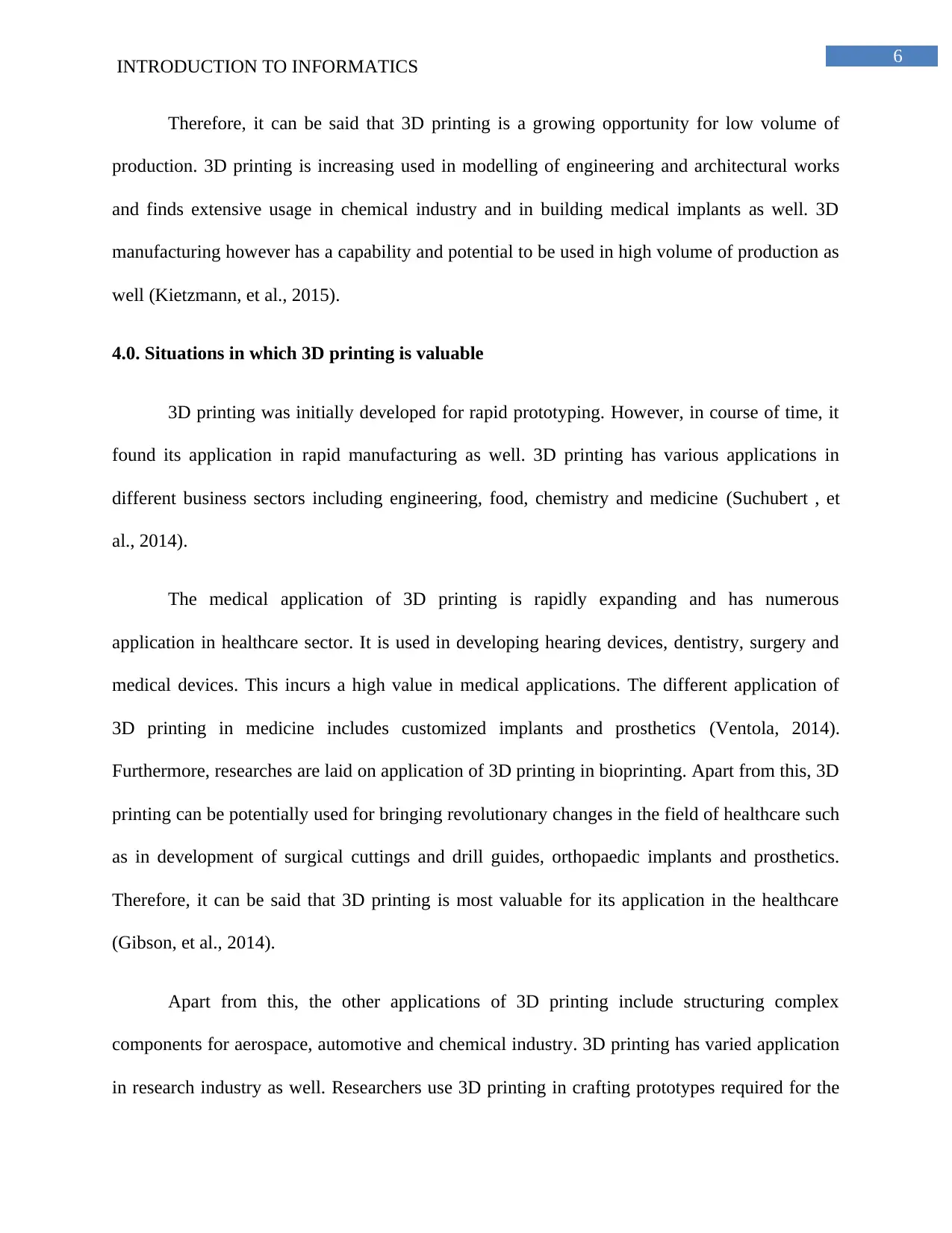
6
INTRODUCTION TO INFORMATICS
Therefore, it can be said that 3D printing is a growing opportunity for low volume of
production. 3D printing is increasing used in modelling of engineering and architectural works
and finds extensive usage in chemical industry and in building medical implants as well. 3D
manufacturing however has a capability and potential to be used in high volume of production as
well (Kietzmann, et al., 2015).
4.0. Situations in which 3D printing is valuable
3D printing was initially developed for rapid prototyping. However, in course of time, it
found its application in rapid manufacturing as well. 3D printing has various applications in
different business sectors including engineering, food, chemistry and medicine (Suchubert , et
al., 2014).
The medical application of 3D printing is rapidly expanding and has numerous
application in healthcare sector. It is used in developing hearing devices, dentistry, surgery and
medical devices. This incurs a high value in medical applications. The different application of
3D printing in medicine includes customized implants and prosthetics (Ventola, 2014).
Furthermore, researches are laid on application of 3D printing in bioprinting. Apart from this, 3D
printing can be potentially used for bringing revolutionary changes in the field of healthcare such
as in development of surgical cuttings and drill guides, orthopaedic implants and prosthetics.
Therefore, it can be said that 3D printing is most valuable for its application in the healthcare
(Gibson, et al., 2014).
Apart from this, the other applications of 3D printing include structuring complex
components for aerospace, automotive and chemical industry. 3D printing has varied application
in research industry as well. Researchers use 3D printing in crafting prototypes required for the
INTRODUCTION TO INFORMATICS
Therefore, it can be said that 3D printing is a growing opportunity for low volume of
production. 3D printing is increasing used in modelling of engineering and architectural works
and finds extensive usage in chemical industry and in building medical implants as well. 3D
manufacturing however has a capability and potential to be used in high volume of production as
well (Kietzmann, et al., 2015).
4.0. Situations in which 3D printing is valuable
3D printing was initially developed for rapid prototyping. However, in course of time, it
found its application in rapid manufacturing as well. 3D printing has various applications in
different business sectors including engineering, food, chemistry and medicine (Suchubert , et
al., 2014).
The medical application of 3D printing is rapidly expanding and has numerous
application in healthcare sector. It is used in developing hearing devices, dentistry, surgery and
medical devices. This incurs a high value in medical applications. The different application of
3D printing in medicine includes customized implants and prosthetics (Ventola, 2014).
Furthermore, researches are laid on application of 3D printing in bioprinting. Apart from this, 3D
printing can be potentially used for bringing revolutionary changes in the field of healthcare such
as in development of surgical cuttings and drill guides, orthopaedic implants and prosthetics.
Therefore, it can be said that 3D printing is most valuable for its application in the healthcare
(Gibson, et al., 2014).
Apart from this, the other applications of 3D printing include structuring complex
components for aerospace, automotive and chemical industry. 3D printing has varied application
in research industry as well. Researchers use 3D printing in crafting prototypes required for the
Paraphrase This Document
Need a fresh take? Get an instant paraphrase of this document with our AI Paraphraser
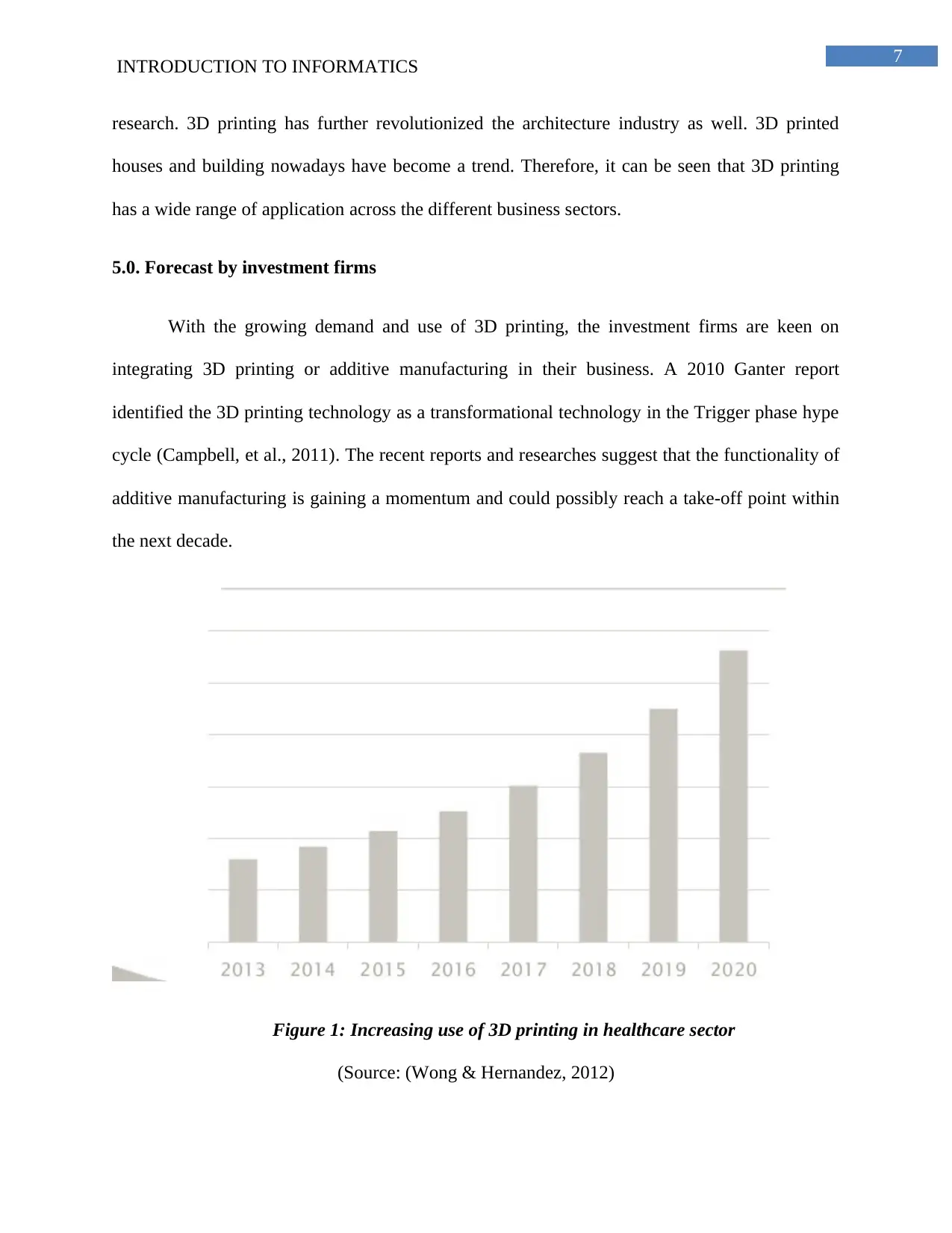
7
INTRODUCTION TO INFORMATICS
research. 3D printing has further revolutionized the architecture industry as well. 3D printed
houses and building nowadays have become a trend. Therefore, it can be seen that 3D printing
has a wide range of application across the different business sectors.
5.0. Forecast by investment firms
With the growing demand and use of 3D printing, the investment firms are keen on
integrating 3D printing or additive manufacturing in their business. A 2010 Ganter report
identified the 3D printing technology as a transformational technology in the Trigger phase hype
cycle (Campbell, et al., 2011). The recent reports and researches suggest that the functionality of
additive manufacturing is gaining a momentum and could possibly reach a take-off point within
the next decade.
Figure 1: Increasing use of 3D printing in healthcare sector
(Source: (Wong & Hernandez, 2012)
INTRODUCTION TO INFORMATICS
research. 3D printing has further revolutionized the architecture industry as well. 3D printed
houses and building nowadays have become a trend. Therefore, it can be seen that 3D printing
has a wide range of application across the different business sectors.
5.0. Forecast by investment firms
With the growing demand and use of 3D printing, the investment firms are keen on
integrating 3D printing or additive manufacturing in their business. A 2010 Ganter report
identified the 3D printing technology as a transformational technology in the Trigger phase hype
cycle (Campbell, et al., 2011). The recent reports and researches suggest that the functionality of
additive manufacturing is gaining a momentum and could possibly reach a take-off point within
the next decade.
Figure 1: Increasing use of 3D printing in healthcare sector
(Source: (Wong & Hernandez, 2012)
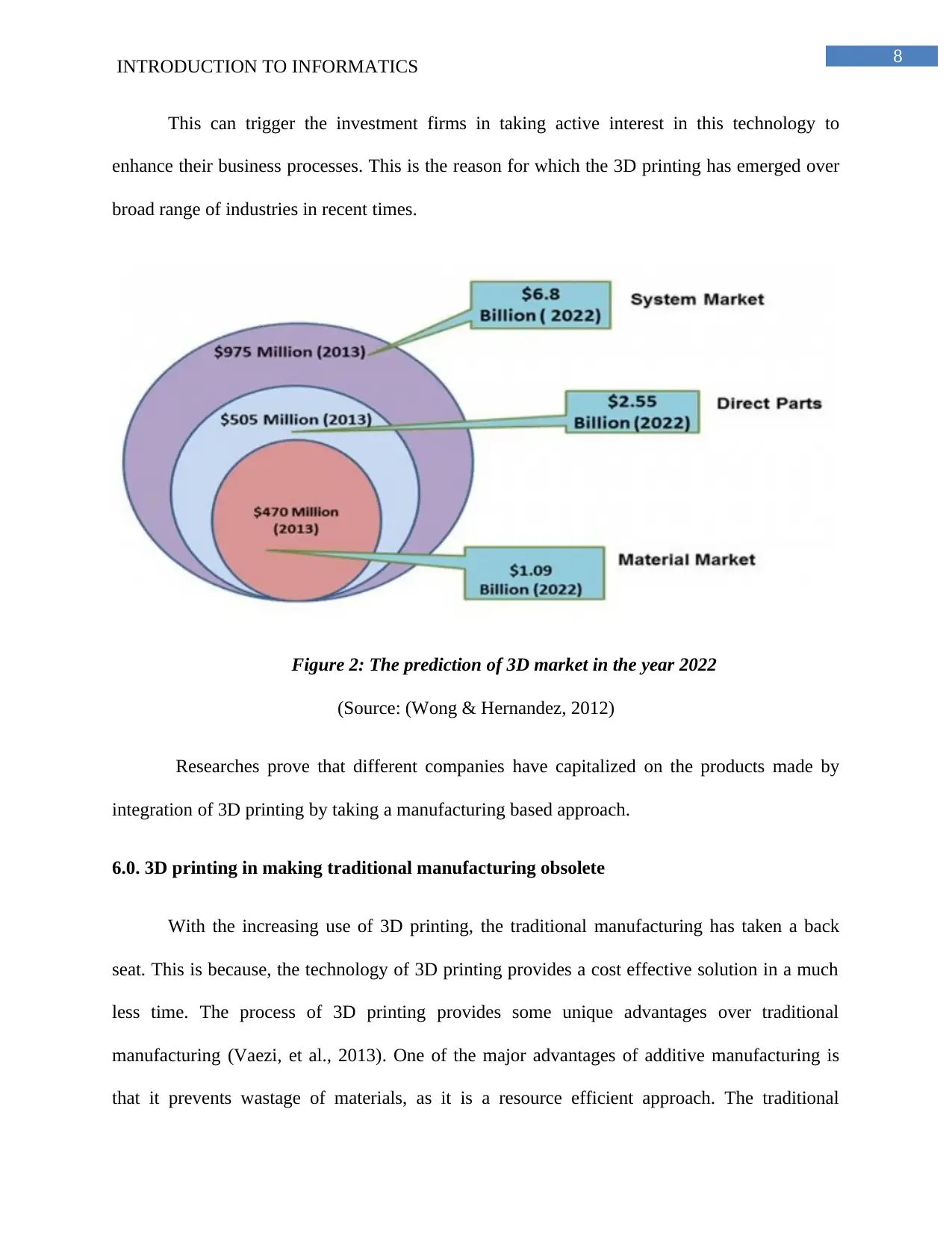
8
INTRODUCTION TO INFORMATICS
This can trigger the investment firms in taking active interest in this technology to
enhance their business processes. This is the reason for which the 3D printing has emerged over
broad range of industries in recent times.
Figure 2: The prediction of 3D market in the year 2022
(Source: (Wong & Hernandez, 2012)
Researches prove that different companies have capitalized on the products made by
integration of 3D printing by taking a manufacturing based approach.
6.0. 3D printing in making traditional manufacturing obsolete
With the increasing use of 3D printing, the traditional manufacturing has taken a back
seat. This is because, the technology of 3D printing provides a cost effective solution in a much
less time. The process of 3D printing provides some unique advantages over traditional
manufacturing (Vaezi, et al., 2013). One of the major advantages of additive manufacturing is
that it prevents wastage of materials, as it is a resource efficient approach. The traditional
INTRODUCTION TO INFORMATICS
This can trigger the investment firms in taking active interest in this technology to
enhance their business processes. This is the reason for which the 3D printing has emerged over
broad range of industries in recent times.
Figure 2: The prediction of 3D market in the year 2022
(Source: (Wong & Hernandez, 2012)
Researches prove that different companies have capitalized on the products made by
integration of 3D printing by taking a manufacturing based approach.
6.0. 3D printing in making traditional manufacturing obsolete
With the increasing use of 3D printing, the traditional manufacturing has taken a back
seat. This is because, the technology of 3D printing provides a cost effective solution in a much
less time. The process of 3D printing provides some unique advantages over traditional
manufacturing (Vaezi, et al., 2013). One of the major advantages of additive manufacturing is
that it prevents wastage of materials, as it is a resource efficient approach. The traditional
⊘ This is a preview!⊘
Do you want full access?
Subscribe today to unlock all pages.

Trusted by 1+ million students worldwide
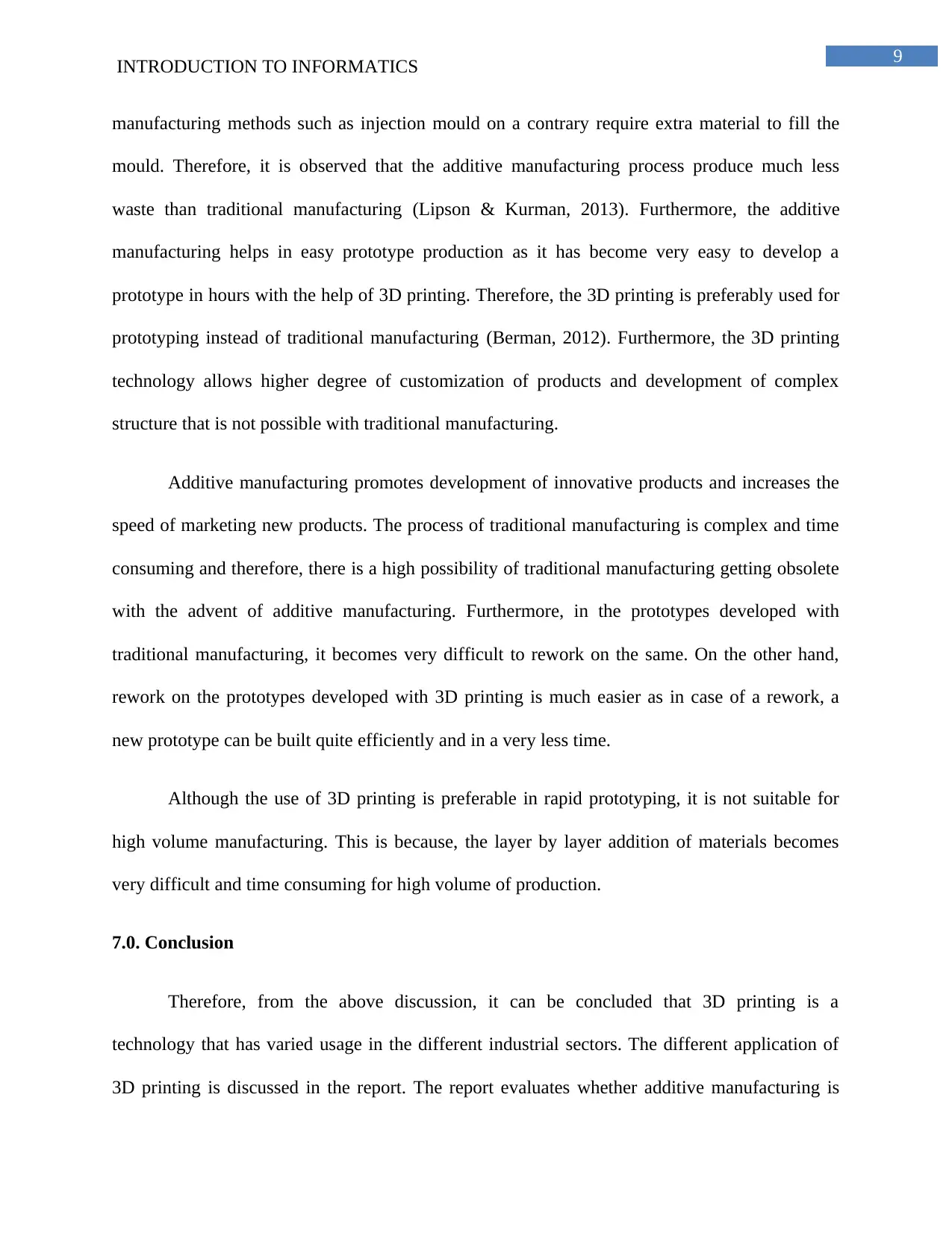
9
INTRODUCTION TO INFORMATICS
manufacturing methods such as injection mould on a contrary require extra material to fill the
mould. Therefore, it is observed that the additive manufacturing process produce much less
waste than traditional manufacturing (Lipson & Kurman, 2013). Furthermore, the additive
manufacturing helps in easy prototype production as it has become very easy to develop a
prototype in hours with the help of 3D printing. Therefore, the 3D printing is preferably used for
prototyping instead of traditional manufacturing (Berman, 2012). Furthermore, the 3D printing
technology allows higher degree of customization of products and development of complex
structure that is not possible with traditional manufacturing.
Additive manufacturing promotes development of innovative products and increases the
speed of marketing new products. The process of traditional manufacturing is complex and time
consuming and therefore, there is a high possibility of traditional manufacturing getting obsolete
with the advent of additive manufacturing. Furthermore, in the prototypes developed with
traditional manufacturing, it becomes very difficult to rework on the same. On the other hand,
rework on the prototypes developed with 3D printing is much easier as in case of a rework, a
new prototype can be built quite efficiently and in a very less time.
Although the use of 3D printing is preferable in rapid prototyping, it is not suitable for
high volume manufacturing. This is because, the layer by layer addition of materials becomes
very difficult and time consuming for high volume of production.
7.0. Conclusion
Therefore, from the above discussion, it can be concluded that 3D printing is a
technology that has varied usage in the different industrial sectors. The different application of
3D printing is discussed in the report. The report evaluates whether additive manufacturing is
INTRODUCTION TO INFORMATICS
manufacturing methods such as injection mould on a contrary require extra material to fill the
mould. Therefore, it is observed that the additive manufacturing process produce much less
waste than traditional manufacturing (Lipson & Kurman, 2013). Furthermore, the additive
manufacturing helps in easy prototype production as it has become very easy to develop a
prototype in hours with the help of 3D printing. Therefore, the 3D printing is preferably used for
prototyping instead of traditional manufacturing (Berman, 2012). Furthermore, the 3D printing
technology allows higher degree of customization of products and development of complex
structure that is not possible with traditional manufacturing.
Additive manufacturing promotes development of innovative products and increases the
speed of marketing new products. The process of traditional manufacturing is complex and time
consuming and therefore, there is a high possibility of traditional manufacturing getting obsolete
with the advent of additive manufacturing. Furthermore, in the prototypes developed with
traditional manufacturing, it becomes very difficult to rework on the same. On the other hand,
rework on the prototypes developed with 3D printing is much easier as in case of a rework, a
new prototype can be built quite efficiently and in a very less time.
Although the use of 3D printing is preferable in rapid prototyping, it is not suitable for
high volume manufacturing. This is because, the layer by layer addition of materials becomes
very difficult and time consuming for high volume of production.
7.0. Conclusion
Therefore, from the above discussion, it can be concluded that 3D printing is a
technology that has varied usage in the different industrial sectors. The different application of
3D printing is discussed in the report. The report evaluates whether additive manufacturing is
Paraphrase This Document
Need a fresh take? Get an instant paraphrase of this document with our AI Paraphraser
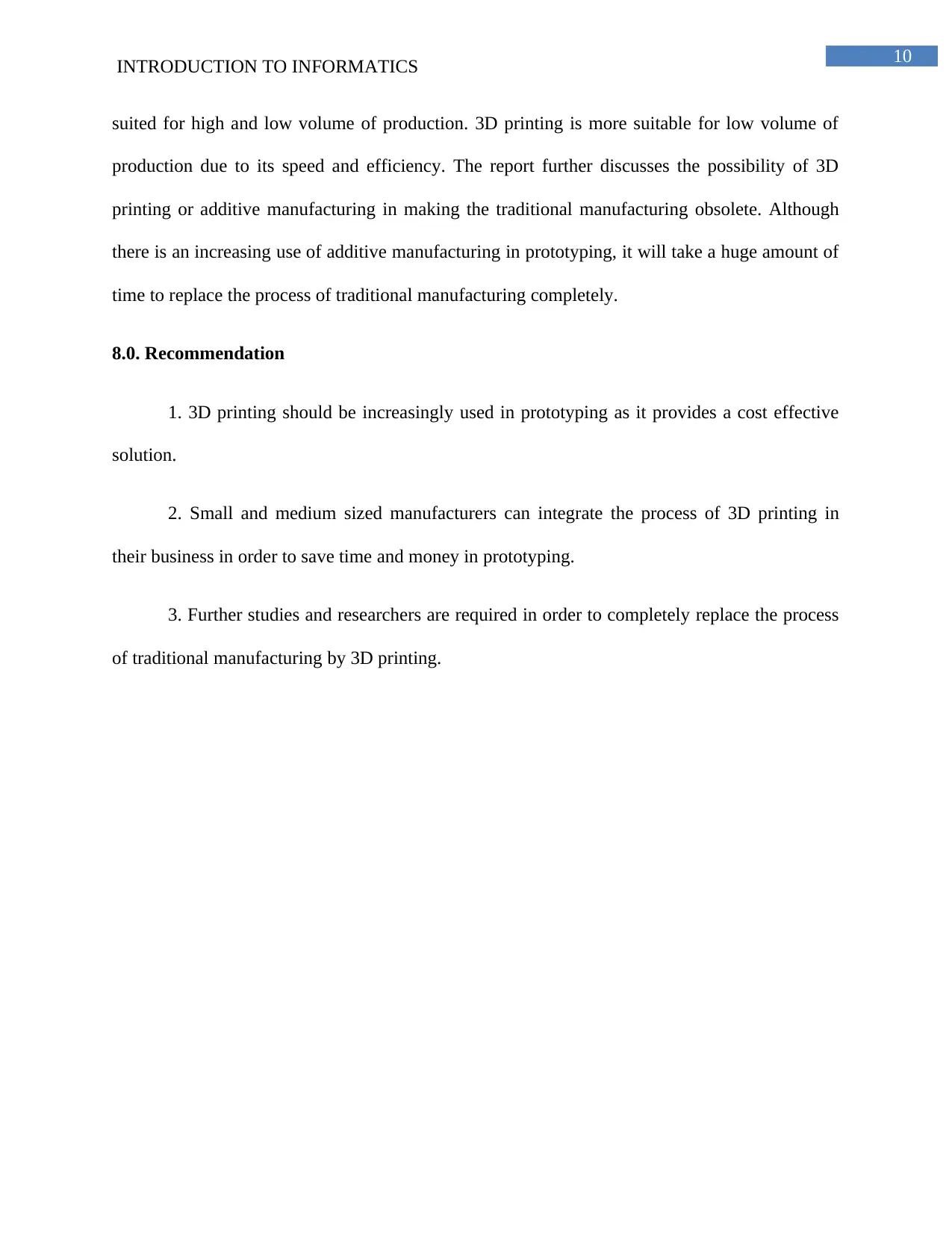
10
INTRODUCTION TO INFORMATICS
suited for high and low volume of production. 3D printing is more suitable for low volume of
production due to its speed and efficiency. The report further discusses the possibility of 3D
printing or additive manufacturing in making the traditional manufacturing obsolete. Although
there is an increasing use of additive manufacturing in prototyping, it will take a huge amount of
time to replace the process of traditional manufacturing completely.
8.0. Recommendation
1. 3D printing should be increasingly used in prototyping as it provides a cost effective
solution.
2. Small and medium sized manufacturers can integrate the process of 3D printing in
their business in order to save time and money in prototyping.
3. Further studies and researchers are required in order to completely replace the process
of traditional manufacturing by 3D printing.
INTRODUCTION TO INFORMATICS
suited for high and low volume of production. 3D printing is more suitable for low volume of
production due to its speed and efficiency. The report further discusses the possibility of 3D
printing or additive manufacturing in making the traditional manufacturing obsolete. Although
there is an increasing use of additive manufacturing in prototyping, it will take a huge amount of
time to replace the process of traditional manufacturing completely.
8.0. Recommendation
1. 3D printing should be increasingly used in prototyping as it provides a cost effective
solution.
2. Small and medium sized manufacturers can integrate the process of 3D printing in
their business in order to save time and money in prototyping.
3. Further studies and researchers are required in order to completely replace the process
of traditional manufacturing by 3D printing.
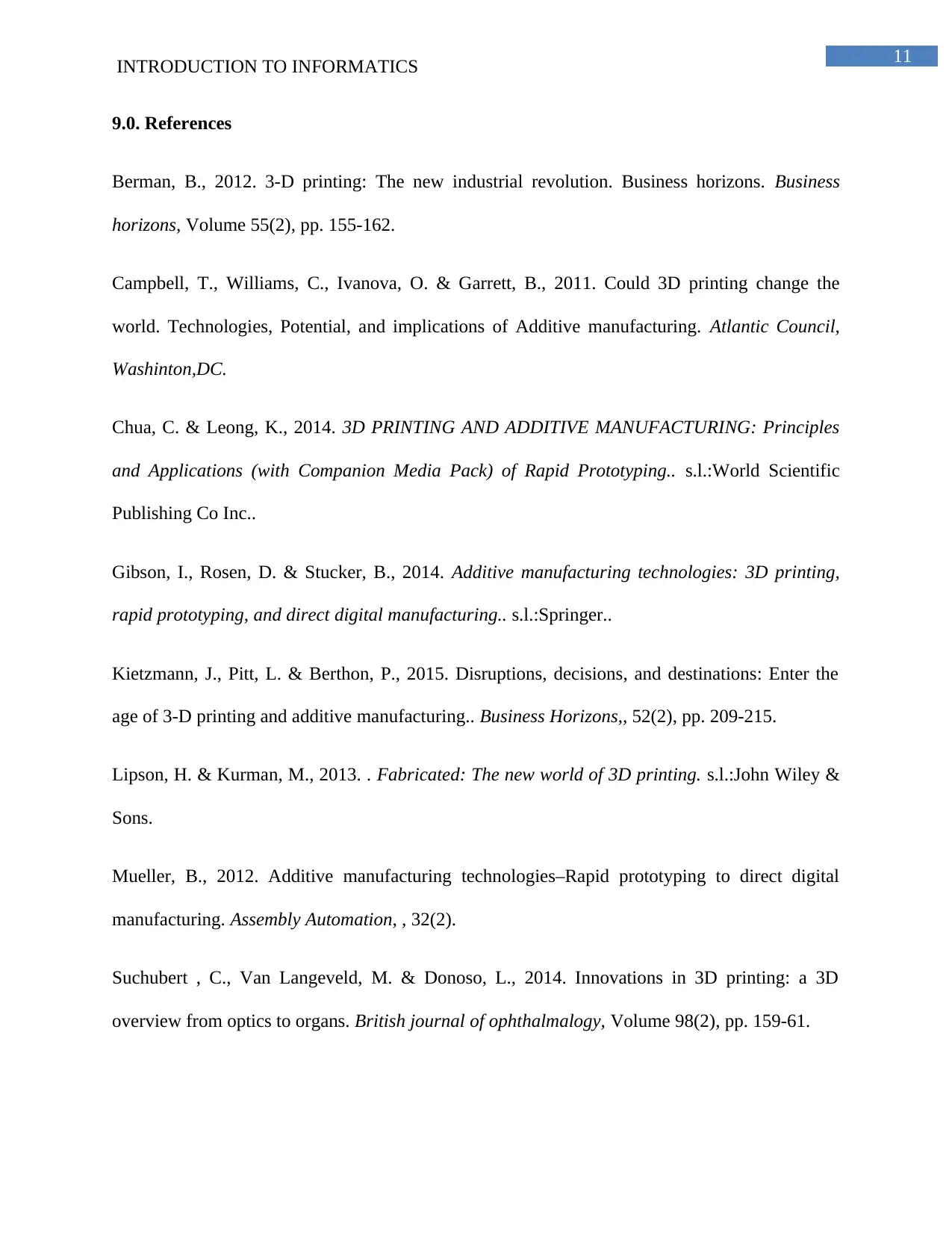
11
INTRODUCTION TO INFORMATICS
9.0. References
Berman, B., 2012. 3-D printing: The new industrial revolution. Business horizons. Business
horizons, Volume 55(2), pp. 155-162.
Campbell, T., Williams, C., Ivanova, O. & Garrett, B., 2011. Could 3D printing change the
world. Technologies, Potential, and implications of Additive manufacturing. Atlantic Council,
Washinton,DC.
Chua, C. & Leong, K., 2014. 3D PRINTING AND ADDITIVE MANUFACTURING: Principles
and Applications (with Companion Media Pack) of Rapid Prototyping.. s.l.:World Scientific
Publishing Co Inc..
Gibson, I., Rosen, D. & Stucker, B., 2014. Additive manufacturing technologies: 3D printing,
rapid prototyping, and direct digital manufacturing.. s.l.:Springer..
Kietzmann, J., Pitt, L. & Berthon, P., 2015. Disruptions, decisions, and destinations: Enter the
age of 3-D printing and additive manufacturing.. Business Horizons,, 52(2), pp. 209-215.
Lipson, H. & Kurman, M., 2013. . Fabricated: The new world of 3D printing. s.l.:John Wiley &
Sons.
Mueller, B., 2012. Additive manufacturing technologies–Rapid prototyping to direct digital
manufacturing. Assembly Automation, , 32(2).
Suchubert , C., Van Langeveld, M. & Donoso, L., 2014. Innovations in 3D printing: a 3D
overview from optics to organs. British journal of ophthalmalogy, Volume 98(2), pp. 159-61.
INTRODUCTION TO INFORMATICS
9.0. References
Berman, B., 2012. 3-D printing: The new industrial revolution. Business horizons. Business
horizons, Volume 55(2), pp. 155-162.
Campbell, T., Williams, C., Ivanova, O. & Garrett, B., 2011. Could 3D printing change the
world. Technologies, Potential, and implications of Additive manufacturing. Atlantic Council,
Washinton,DC.
Chua, C. & Leong, K., 2014. 3D PRINTING AND ADDITIVE MANUFACTURING: Principles
and Applications (with Companion Media Pack) of Rapid Prototyping.. s.l.:World Scientific
Publishing Co Inc..
Gibson, I., Rosen, D. & Stucker, B., 2014. Additive manufacturing technologies: 3D printing,
rapid prototyping, and direct digital manufacturing.. s.l.:Springer..
Kietzmann, J., Pitt, L. & Berthon, P., 2015. Disruptions, decisions, and destinations: Enter the
age of 3-D printing and additive manufacturing.. Business Horizons,, 52(2), pp. 209-215.
Lipson, H. & Kurman, M., 2013. . Fabricated: The new world of 3D printing. s.l.:John Wiley &
Sons.
Mueller, B., 2012. Additive manufacturing technologies–Rapid prototyping to direct digital
manufacturing. Assembly Automation, , 32(2).
Suchubert , C., Van Langeveld, M. & Donoso, L., 2014. Innovations in 3D printing: a 3D
overview from optics to organs. British journal of ophthalmalogy, Volume 98(2), pp. 159-61.
⊘ This is a preview!⊘
Do you want full access?
Subscribe today to unlock all pages.

Trusted by 1+ million students worldwide
1 out of 13
Related Documents
Your All-in-One AI-Powered Toolkit for Academic Success.
+13062052269
info@desklib.com
Available 24*7 on WhatsApp / Email
![[object Object]](/_next/static/media/star-bottom.7253800d.svg)
Unlock your academic potential
Copyright © 2020–2025 A2Z Services. All Rights Reserved. Developed and managed by ZUCOL.





